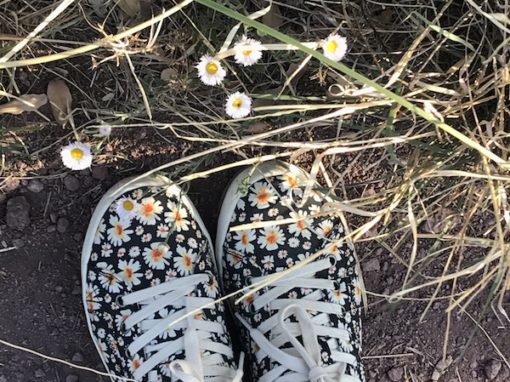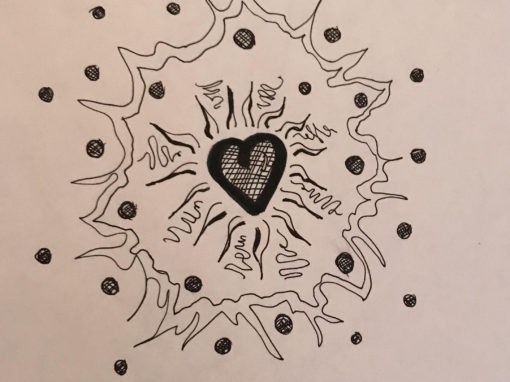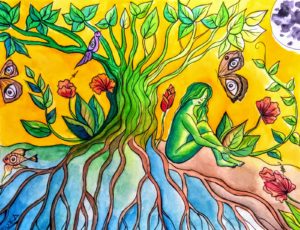In NVC, nonviolent communication,* we focus on feelings and needs. When needs are not met, conflicts arise. Strategies are the ways we try to get our needs met. This week, in reflecting with friends in an NVC practice group focused on social justice, the question was raised:
How does racism and white supremacy live in me and what needs are they meeting?
I began to think of white supremacy as integrated inside of me, but not all of me, like a very well-trained, highly-evolved parasite residing in my white body host. A parasite that controls me, that I helped create, and that I feed. I started to question:
Where does white supremacy lodge in my being? How does it feel? What does it sound like? Taste like? Smell like? How can I better get to know this entity?
I thought back to specific moments I had harmed people of color in my life, As a white woman living in the U.S. there are many. The majority were unintentional. Some were intentional even if I didn’t quite know that. And all caused harm.
I began to see the character of white supremacy and how terrifyingly evolved it is become. I also realized that, as anti-racist scholars have always said, white supremacy lives and thrives in silence. It feeds on it. That’s one of the reasons why it’s so hard for white folks to talk about racism. As Layla F. Saad and Ibram X. Kendi and Robin DiAngelo and Jane Elliot and many other race scholars explain, white fragility keeps white folks from learning and from growing. Ibram X. Kendi encourages folks to focus on racist policy and racist ideas that create racial equity or inequity.
If I imagined white supremacy to be this evil, white-man-created parasite living in my body right now, I realized that in order to kill it, I had to see it. I also had to name it. Listen to it. Observe it. Know it. Me writing this is part of my continuation of knowing the face, voice, sound, movements of white supremacy living in me.
White Supremacy in Action: A Snapshot
A few years ago, on a semester abroad program I was leading, I touched the hair of a black student. We had been traveling for three months together, this group of 26 students and I, as well as other staff. We had explored racism, classism, sexism and health access in four different countries as we journeyed. At this moment, towards the very end of our trip, I was celebrating creating many bonds with students. And yet, I was deeply aware of the areas for improvement. In our program, slightly more than half of the students were students of color. The majority of our staff were white women. Though we talked about racism frequently, there were many things I, and we as staff, could have done differently and better to talk about white supremacy and colorism in honest, direct ways.
I was jittery and excited that afternoon. I’d been talking to an ex of mine on the phone and reconnecting. When I’m in this excited space, full of ideas and new energy, I become more childlike. Playful. Craving intimacy. I was lost in self, marveling at how my life had led me to this eco-farm in Brazil.
So this student and I were sitting and reflecting amidst this context. Our conversation wove from relationships to beauty and skincare to our love for writing. The sun was hot on our skin. Sweat beads were gathering on my neck. Green palm fronds and thick trees covered the mountains around us. We were sitting outside the dining area, a covered patio with a long table. The walls were painted with murals and birds were chirping while the dull hum of students in the background added to the sleepy weight of the late afternoon.
This student let out her hair, which had been tied up, into its afro. It was a style I hadn’t seen her wear much during the trip. Noticing it, I commented on it. I don’t remember what I said at first; I didn’t dwell on my intention. I was in that blissed out state; everything was beautiful! That state of light and love, as many spiritual women, mostly white, say to one another. And in that moment, a shift happened. An opportunity presented itself, and white supremacy spoke up. I opened my mouth and spoke,
“I know I shouldn’t. I know it’s not the right thing to do but, it’s just so beautiful, your hair. Can I touch it, just for a second?”
Even as I said these words, an alarm subtly rang inside of me. What are you doing? It questioned. You have watched videos about touching black women’s hair. You have read books. You have talked about this exact type of microaggression even with this group of students. You know this is wrong…
And yet, in that moment, that other voice came through. Quiet. Subtle. Dominating. The voice of white supremacy insidiously crept forward, moving through the anti-racist training I’d been slowly building up after a lifetime of racist inundation and privilege. It crept through my core, it clutched my heart. It grasped this opportunity. This moment of sweetness, formed after an hour of chatting, became the perfect moment to attack. Even as I asked my student if I could touch her hair, part of me knowing this was wrong, the other part of me was comforted by white supremacy’s voice, whispering…
It’s ok, Kristen. This is different. You two are just hanging out. Yeah, it’s bad to touch black women’s hair, but now she’s your friend. She’s your student. This is different. You’re close. You’re laughing. You’re in. You’ve gotten in with the black women in your group. Finally. Celebrate this. It’s innocent. It’s ok. Go ahead.
Whew. It just scared me to write that. I hear my own white supremacy voice right now saying, “Don’t air that! That’s private! That’s not supposed to be talked about!” And that is why I have to talk about it. That is why we, white people, have to talk about how white supremacy lives in us and how it sounds. Because if we don’t pay attention to it, if we don’t start to listen for it, we will let it take over and direct our thoughts, actions, emotions, and beliefs.

What Does White Supremacy Need?
I have thought about this moment more recently from the framework of NVC. What needs did I have in that moment? What needs did my student have? What needs did white supremacy have? For me, I had needs for inclusion, intimacy, belonging, and validation. I put these needs, my personal needs, above the needs of black people and of my student. I imagine her needs then, as often, were for safety, autonomy, and equity, among others I cannot know. I didn’t ask her.
“Sure, that’s ok,” my student said after a pause. That’s ok, I heard. I tried to ignore the pause. Reaching forward, I touched her hair.
I can’t remember what the texture of her hair felt like. I can’t remember what I thought I would get out of that experience. Writing that, “what I thought I would get,” just emphasizes the transactional power move of that moment. I do remember that what I received felt like validation. It was confirmation of my domination over her, of a white woman’s domination over a black woman, of an older white female teacher’s domination of a younger, black female student. I remember feeling like “I was in.”
True intimacy, to know someone, and to be known, is not to be taken lightly. “To be in” with a person or group of people is lifelong work. I’ve learned intimacy can be wielded like a weapon; it easily manipulates and is easily manipulated. Intimacy power moves make me remember men in my past who have manipulated me under that disguised need. And I, an obliging, loving, cis-gendered woman, have wanted to satisfy that need.
In this moment with my student, the connection I thought I needed I needed with her– that intimate gesture, the touching of her hair– was masked. That move wasn’t about intimacy as much as it was about validation and, ultimately, about belonging. I wanted to belong to the sacred inner circle of my Black students. I wanted to be part of a group of people who, no matter how close I might be to some Black students or friends, no matter how many laughs we might share, no matter how much they might trust me– I can never fully belong. And that is important to acknowledge.
White people’s need for intimate belonging in the inner sanctuary of a group of a different race is yet another form of how white supremacy is adapting in this day and age.
To belong is to be included, but what if you cannot be included? That is when belonging, a universal human need, becomes yet another form of oppressing. The act of belonging becomes an act of forcing one’s place into another’s group. The act of belonging becomes the act of colonizing.
Even and especially in sacred Black spaces, white people want to belong. We might fetishize or exoticize: What is an all-Black church like? What would a wailing circle be like? We want to know, even though we know there are some things we cannot know, and that is ok. That is more than ok. That is safety for Black folks who, in their bodies, minds, hearts, continue to hold the legacy, past and present, of fearing white people.
It’s interesting to write about belonging because of the hypocrisy of what belonging means. White folks want to feel included even in this world where we have intentionally excluded people of color in so many ways. We have othered. We have separated. We have segregated. We have enslaved. We have enforced. We have imprisoned. We haven’t created spaces where Black people, indigenous people, Latinx folks and other people of color feel like they belong, and yet, and still, we yearn to belong to them.
When we are told no, we get confused, sad, angry. White supremacy rears its head and rewrites the script. “That’s not fair!” We might protest. White people do not like being told no. It is tragically ironic, yet again, considering all the times we have said no to black, brown, indigenous, Asian, Middle Eastern people for centuries. Not to mention saying “No” to all of the other identities that are not systemically in power. The white, cis-gendered, heteronormative, able-bodied, middle-upper middle class, English speaking man loves the word “No!”
As soon as white supremacy, living in me, saw this opportunity to belong, to do that thing I wasn’t supposed to do as a white woman, in a “safe and acceptable way,” it encouraged me to dominate and cause harm. I had the privilege to remove myself from the gesture, to see this as an isolated incident unconnected to systemic oppression.
“Touching a black woman’s hair is only something racist white people do,” the white supremacy voice comforted me. I doubted, but that the voice came back. Comforting. Reinforcing. The student said it’s ok. I’m not racist. I’m a good white person. This is different.
I want to reiterate that in the moment, I could not have voiced any of this. It is only after years now of work releasing guilt and analyzing and learning more about white supremacy that I can look back with more clear eyes to this moment and others to see how white supremacy was and is living in me, manipulating me, even when so much of me didn’t want it to.

Evolution of White Supremacy
As well as wanting to belong everywhere, white people also want to feel like we’re special. Nowadays, I see how this shift has occurred in me and other well-intentioned white folks.
We want to feel included in movements of social change because we see the importance of the work, because we believe in justice and equity, and yet, HOW are we showing up in these movements?
I think many white folks are on a proving crusade to show that they are true allies rather than performative allies. I have seen this in myself, this need to prove my allyship. This has become especially visible in the past few months. The underlying heartbeat of white supremacy, this beat beat beat of superiority, exceptionalism and domination lives subtly and powerfully in us. It does not just go away overnight.
What’s particularly dangerous about the protesting, rallying, well-read, well-meaning, liberal white folks is that I reckon many of us still have deep, deep work to do. We might read all the books, watch all the videos, talk about racism with our family members and friends, challenge white supremacy in our work spaces. All of this is important work AND it is not enough.
In this moment of history, talking about white supremacy’s adaptability is vitally important because if white folks don’t take the time to pay attention every moment of every day, how we move forward will not be sustainable.
This moment. We are in the midst of upheaval and revolution. Or, are we? I’ve heard Black folks say they’re suspicious right now. There is hesitancy about large corporations posting two-paragraph statements claiming Black Lives Matter. There is skepticism. There is anger. There is laughter and sadness that it took 130 years to remove Aunt Jemima’s racist legacy. There is disappointment when white celebrities take up more space to voice “I am responsible.” There is a perceptible slowing down of the momentum and that is terrifying.
I imagine the voice of many Black Americans asking: Where were they before? Will they still be here when the fight to end white supremacy isn’t “trending?” What will they do beyond this moment?
Black folks have reason to be suspect. White supremacy, throughout history, has created new guises, new liberalized faces. Just as slavery morphed into Black Codes, Jim Crow, and mass incarceration, white supremacy evolves alongside it.
White supremacy wants to survive, so like any organism, it adapts. Nowadays, white supremacy protests. It donates. It posts videos on social media. It rallies. It even talks about racism and calls out relatives on their racist actions and ideas. Snake-like, slippery, sliding, it glides, nearly undetected, in all white folks and yes, even in well-meaning white folks. It continues to live inside us and the systems we’ve created.
And then, after all that well-intentioned, important anti-racist work, it goes home, curls up in bed, and falls asleep amidst a mantra of righteousness. I’m a good white person, it whispers. I’m not a Karen, it confirms. I would never do what she did. I’m part of the movement. I’m doing my part. Sigh of relief.
It is not enough to just show up, white folks. If we do not constantly examine how white supremacy lives in us, every minute of every day, we will continue to cause harm, as I did, and as I will continue to do. And you know what? You will too. You already have.
It is not a matter of if we will mess up. It is a matter of when. White folks messing up and causing harm to Black and Brown humans is inevitable. It is the product and the process of the white supremacy society that our ancestors built, that we have inherited, that we have lived in, and that we have not yet changed.
So with that knowledge, what can white folks do? Even knowing it is not enough, first, we keep showing up. We say sorry. We get up. We don’t isolate amongst white-person pity cuddle parties. We learn. We study. We come back to the table. We speak. We move forward. We create a better, more just world. We ask twice. We apologize. We learn to listen to no. We examine our power. We learn when to say yes. And we keep on working beyond this moment. We work for all moments. That is how we will understand the white supremacy that lives in us. That is how we will see it, know it, starve it, and hopefully even, one day, destroy it.
*A note on NVC. Nonviolent communication was created by Marshall Rosenberg. It is a language that navigates conflict. The NVC community is in the midst of many conversations around representation, equity, and power. NVC is going through growing pains as it confronts its own white supremacy. As I’ve interpreted it, the core of the issue is that all needs are not created equal in a white supremacy, patriarchal, heteronormative society where needs for safety, equity, inclusion are not met for people of color, LGBTQI+ folks, and women and female-identifying folks. Therefore, when we talk about needs, that acknowledgment has to be incorporated into the framework, conversation, and solutions.
There is also frustration around the use of formulaic language to express feelings and needs, the idea that these formulas comes across as restrictive and dominating. For me, I’ve found that NVC is a framework that has helped me grow tremendously, helped me address conflict and what my true need is, and yet, it is not a full experience for me. It is part of my practice. I also try to integrate somatic work, creative writing, and constant checking of my practice along the lines of structural, cultural, interpersonal, and personal power systems at play. (I learned that framework from NVC practitioner Roxy Manning).




